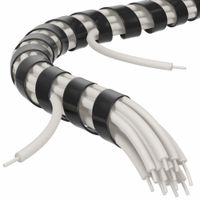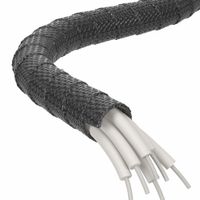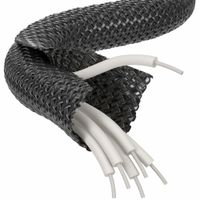Call +(254) 703 030 000 / 751 483 999 / 721 704 777
- Home
- Electrical
- Wire Cable Management
- Cable Sleeving Wraps
.....Read More
Frequently Asked Questions
What is the difference between expandable and standard cable sleeving?
Expandable cable sleeving and standard cable sleeving differ primarily in their construction, flexibility, and application.
Expandable Cable Sleeving:
1. **Construction**: Made from braided materials, often polyester or nylon, that can expand and contract. The weave allows the sleeving to stretch and accommodate various cable sizes.
2. **Flexibility**: Highly flexible due to its braided design, making it suitable for irregularly shaped cables or bundles.
3. **Application**: Ideal for situations where cables need to be added or removed frequently. It provides a snug fit around cables of different diameters, offering protection and organization.
4. **Installation**: Easy to install by simply pushing the cables through the sleeving. The expandable nature allows it to fit over connectors and other protrusions.
5. **Protection**: Offers abrasion resistance and some level of thermal protection, though not as robust as some standard sleeving options.
Standard Cable Sleeving:
1. **Construction**: Typically made from materials like PVC, rubber, or other non-expandable plastics. It comes in fixed diameters.
2. **Flexibility**: Less flexible compared to expandable sleeving, as it does not stretch. It is more rigid and maintains its shape.
3. **Application**: Used for cables that do not require frequent changes. It is suitable for environments where cables are subject to minimal movement.
4. **Installation**: Requires precise measurement and cutting to fit the cables. It may need to be split or cut to accommodate connectors.
5. **Protection**: Provides excellent protection against environmental factors, including moisture, chemicals, and physical impact, depending on the material used.
In summary, expandable sleeving is versatile and adaptable, while standard sleeving offers more robust protection but requires precise installation.
How do you install cable sleeving and wraps?
To install cable sleeving and wraps, follow these steps:
1. **Select the Right Sleeving**: Choose the appropriate type and size of sleeving for your cables. Consider factors like flexibility, heat resistance, and diameter.
2. **Measure and Cut**: Measure the length of the cable you want to cover and cut the sleeving slightly longer to allow for adjustments.
3. **Prepare the Cables**: Disconnect power and any connected devices. Organize and bundle the cables using zip ties or Velcro straps to make them easier to sleeve.
4. **Insert Cables into Sleeving**: For expandable braided sleeving, push the sleeving over the cable bundle, expanding it as needed. For split sleeving, simply wrap it around the cables.
5. **Secure the Ends**: Use heat shrink tubing or electrical tape to secure the ends of the sleeving. Slide the heat shrink over the sleeving ends and apply heat with a heat gun to shrink it in place.
6. **Install Cable Wraps**: For spiral or Velcro wraps, start at one end of the cable bundle and wrap tightly around the cables, ensuring even coverage.
7. **Check and Adjust**: Ensure the sleeving or wrap is snug and covers the entire length of the cables. Make any necessary adjustments for a neat finish.
8. **Reinstall and Test**: Reconnect the cables to their devices and power source. Test to ensure everything is functioning correctly.
9. **Maintenance**: Periodically check the sleeving and wraps for wear and tear, replacing them as needed to maintain cable protection and organization.
What materials are commonly used for cable sleeving?
Cable sleeving is an essential component in cable management, providing protection, organization, and aesthetic enhancement. Common materials used for cable sleeving include:
1. **Nylon**: Known for its durability and flexibility, nylon is resistant to abrasion and chemicals, making it ideal for industrial applications. It can withstand high temperatures and is often used in environments where cables are exposed to harsh conditions.
2. **Polyethylene Terephthalate (PET)**: PET is a popular choice due to its excellent abrasion resistance and flexibility. It is lightweight, easy to install, and available in various colors and sizes, making it suitable for both industrial and consumer applications.
3. **Polyvinyl Chloride (PVC)**: PVC sleeving is cost-effective and provides good insulation and protection against moisture and chemicals. It is commonly used in household and office environments for organizing and protecting cables.
4. **Fiberglass**: This material is used for high-temperature applications due to its excellent heat resistance. Fiberglass sleeving is often coated with silicone or acrylic to enhance its protective properties and is used in automotive and aerospace industries.
5. **Silicone**: Silicone sleeving offers excellent thermal stability and flexibility. It is resistant to extreme temperatures and is often used in environments where cables are exposed to high heat or cold.
6. **Polyolefin**: This material is used for heat-shrinkable sleeving, which provides a tight fit around cables when heat is applied. It offers good electrical insulation and is used in both industrial and consumer applications.
7. **Kevlar**: Known for its high tensile strength, Kevlar sleeving is used in applications requiring extreme durability and protection against cuts and abrasion. It is often used in military and aerospace industries.
These materials are selected based on the specific requirements of the application, such as temperature resistance, flexibility, durability, and cost.
How do you choose the right size of cable sleeving?
To choose the right size of cable sleeving, follow these steps:
1. **Determine the Cable Bundle Diameter**: Measure the diameter of the cable or bundle of cables you intend to sleeve. Use a caliper or a flexible measuring tape for accuracy. If measuring a bundle, ensure the cables are tightly grouped as they will be when sleeved.
2. **Select the Sleeve Type**: Decide on the type of sleeving material based on your needs. Common types include braided, expandable, heat-shrink, and split sleeving. Consider factors like flexibility, abrasion resistance, heat resistance, and ease of installation.
3. **Check Expandability**: For expandable sleeving, consider its expansion ratio, which indicates how much the sleeve can stretch. Choose a sleeve that can expand to fit over the largest part of your cable bundle but will contract to fit snugly.
4. **Match Sleeve Diameter to Cable Diameter**: Choose a sleeve with a nominal diameter slightly smaller than the cable bundle diameter for a snug fit. For example, if your cable bundle is 10mm in diameter, a sleeve with a nominal diameter of 8mm that can expand to 16mm would be appropriate.
5. **Consider Heat-Shrink Sleeving**: If using heat-shrink sleeving, select a size that fits over the largest part of the cable bundle before shrinking. Ensure the shrink ratio is sufficient to tightly conform to the smallest part of the cable after shrinking.
6. **Account for Connectors**: If the cable has connectors, ensure the sleeving can fit over them. You may need a larger diameter or a split sleeving that can be wrapped around the cable.
7. **Test Fit**: If possible, test the fit with a small section of sleeving to ensure it meets your requirements before purchasing in bulk.
By following these steps, you can select the appropriate size of cable sleeving for your specific application.
Can cable sleeving be used outdoors?
Yes, cable sleeving can be used outdoors, but it is essential to choose the right type of sleeving material to ensure durability and protection against environmental factors. Outdoor conditions can be harsh, with exposure to UV rays, moisture, temperature fluctuations, and physical abrasion. Therefore, selecting a sleeving material that can withstand these elements is crucial.
1. **Material Selection**:
- **Polyethylene Terephthalate (PET)**: This is a common choice for outdoor use due to its resistance to abrasion and UV rays. It is flexible and can withstand a range of temperatures.
- **Nylon**: Known for its toughness and abrasion resistance, nylon sleeving is suitable for outdoor applications, although it may not be as UV resistant as PET.
- **Polyolefin**: Often used for heat shrink tubing, polyolefin provides excellent protection against moisture and chemicals, making it suitable for outdoor environments.
- **PVC**: While not as durable as other materials, PVC can be used outdoors if it is UV stabilized.
2. **UV Resistance**: Ensure the sleeving is UV resistant to prevent degradation from sunlight exposure. UV-resistant coatings or additives can enhance the longevity of the sleeving.
3. **Moisture and Chemical Resistance**: For areas prone to rain or chemical exposure, choose sleeving that offers protection against moisture and chemicals to prevent corrosion or damage to the cables.
4. **Temperature Tolerance**: Consider the temperature range the sleeving can withstand, especially in regions with extreme weather conditions.
5. **Installation Considerations**: Proper installation is crucial to ensure the sleeving provides adequate protection. Ensure that the sleeving is securely fastened and sealed to prevent water ingress.
By selecting the appropriate material and ensuring proper installation, cable sleeving can effectively protect cables in outdoor environments.
How do you remove cable sleeving once installed?
To remove cable sleeving once installed, follow these steps:
1. **Identify the Type of Sleeving**: Determine if the sleeving is expandable, heat shrink, or split. This will influence the removal method.
2. **Gather Tools**: You may need scissors, a utility knife, or wire cutters. For heat shrink, a heat gun or hairdryer might be necessary.
3. **Power Off and Disconnect**: Ensure all cables are powered off and disconnected from any devices to prevent electrical hazards.
4. **Cut the Sleeving**:
- For expandable sleeving, use scissors or a utility knife to carefully cut along the length of the sleeving. Avoid cutting the cables inside.
- For heat shrink, gently heat the sleeving with a heat gun to soften it, then use a utility knife to slice it open.
- For split sleeving, simply peel it away from the cables.
5. **Remove the Sleeving**:
- Expandable and split sleeving can be pulled off once cut.
- For heat shrink, after cutting, peel it away from the cables.
6. **Inspect Cables**: Check the cables for any damage that might have occurred during the removal process.
7. **Dispose of Sleeving**: Properly dispose of the removed sleeving according to local regulations.
8. **Reapply if Necessary**: If you need to reapply sleeving, ensure the cables are clean and dry before installing new sleeving.
By following these steps, you can safely and effectively remove cable sleeving without damaging the underlying cables.
What are the benefits of using cable sleeving over other cable management solutions?
Cable sleeving offers several benefits over other cable management solutions:
1. **Protection**: Cable sleeving provides a protective layer around cables, shielding them from abrasion, moisture, chemicals, and temperature fluctuations. This extends the lifespan of the cables and reduces the risk of damage.
2. **Organization**: By bundling multiple cables into a single sleeve, cable sleeving helps maintain a neat and organized appearance. This is particularly beneficial in environments with numerous cables, such as data centers or home entertainment systems.
3. **Aesthetic Appeal**: Cable sleeving is available in various colors and materials, allowing for customization to match the surrounding decor or branding. This enhances the visual appeal of cable setups, making them less obtrusive.
4. **Flexibility**: Unlike rigid cable management solutions, sleeving is flexible and can accommodate cables of different sizes and shapes. This makes it easier to route cables through tight spaces or around obstacles.
5. **Ease of Installation**: Cable sleeving is relatively easy to install and can be cut to the desired length. This makes it a convenient option for both professional installers and DIY enthusiasts.
6. **Cost-Effectiveness**: Compared to other cable management solutions like cable trays or raceways, sleeving is often more affordable, providing a cost-effective way to manage cables without compromising on quality.
7. **Noise Reduction**: Sleeving can help reduce electromagnetic interference and noise, which is crucial in environments where signal integrity is important, such as audio or data transmission setups.
8. **Safety**: By keeping cables bundled and out of the way, sleeving reduces the risk of tripping hazards and accidental disconnections, enhancing safety in both residential and commercial settings.





